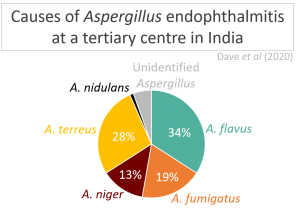Submitted by Aspergillus Administrator on 19 July 2010
Researchers have discovered that vitamin B3 (niacin) has antifungal properties that work against a wide range of fungi including Aspergillus. This is interesting as we already know quite a lot about vitamin B3 and it holds out the prospect of the development of a new antifungal drug family that has far fewer side effects compared with current antifungals drugs.
Even more interestingly vitamin B3 antifungal activity works on strains of the fungus which are resistant to current antifungals – they seem equally as effective against resistant or sensitive strains and this suggests that vitamin B3 works via an entirely different mechanism compared with current antifungal drugs. We mention how important this is in an earlier blog, but to summarise if we can exploit new targets for antifungal activity it should lead to drugs which can treat infections that are resistant to other antifungal drugs, Resistance to current antifungal drugs is something that is an increasing problem in the clinic.
In addition there is the possibility that two drugs that use two different targets for their antifungal activity could be used together and thus have far more effect than either drug when used alone (i.e. combination therapy). Vitamin B3 (or drugs developed from this research) could be a useful addition to this type of therapy.
This is also interesting scientifically as it seems to work through interference with a fungal enzyme that is intimately involved in DNA replication. DNA is closely associated with histone proteins during the cell cycle, effectively packaging it away during quiet times when the cell is not replicating whilst also enabling efficient, ordered unpackaging and replication of DNA prior to cell division and growth (see cartoon animation of this & other processes here).
We have learned that chemical modification (acetylation) of histone is important for the correct control of the cell cycle however we do not know its precise function. Acetylation and deacetylation of histone is carried out by specific enzymes in the cell nucleus, one of which is a target for vitamin B3. Interference with the mechanism of acetylation of histone (by e.g. treating it with vitamin B3) results in the loss of histone and widespread abnormal growth of the fungus. This gives us a little more insight and another tool to look at how this whole mechanism works.
This mechanism of regulation of histone acetylation in fungi seems to be specific to fungi making it a highly attractive target for antifungal therapy, as interfering with this regulation should not interfere with human cell cycle histones, reducing side effects of any resulting antifungal drugs.
News archives
-
Title
Date



